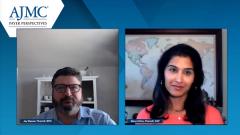
Social Determinants of Health in MDD
Key social determinants affecting MDD are evaluated by Michael Rothrock, MBA, MHA, and H. Eric Cannon, PharmD, FAMCP.
Episodes in this series

H. Eric Cannon, PharmD, FAMCP: Money can’t solve all our problems, but it sure helps. Can you afford your co-pays? Poverty is definitely playing into this. Homeless people [are affected]. We’re starting to work with populations that have recently been discharged from prison. There are people who don’t feel accepted. That acceptance goes across a lot of levels. If I found a physician or a therapist, but I don’t feel accepted or I don’t feel that it’s an inclusive environment, I might not keep going. That plays a role in how a patient feels. Finding ways to be more inclusive is critical for all of us.
Michael Rothrock, MBA, MHA: This is a continuing theme of our last couple of topics. We’ve [spoken] about the socioeconomic status of individuals who are the most challenging to identify and get access and care to, based on their lower income levels. At the end of the day, it comes down to education, affordability, access to care, promotion, and awareness through the workforce and your own internal HR [human resources] departments to say that there are self-help opportunities and ways to get in touch with providers or caregivers to assist you if you or a family member are experiencing symptoms of depression.
This holistic approach becomes much more magnified, and we’re much more aware as a society. We went through 2-plus years of COVID-19, and we’re trying to find the best way to [reach] these patients on a regular basis, or at least provide them the help or care they need so they can invest in themselves. As Dr Cannon mentioned, affordability is one thing. If they can’t afford the co-pays, that’s going to be a challenge. But other ways of finding care through local communities—self-help books, manufacturer-sponsored programs, church groups, even your own colleagues and friends—is something we need to see as an opportunity to [reach] these patients more frequently.
Transcript edited for clarity.
Newsletter
Stay ahead of policy, cost, and value—subscribe to AJMC for expert insights at the intersection of clinical care and health economics.











































